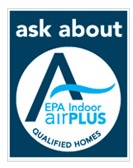 Ahhh….I definitely have a sense of satisfaction from moving on to the next, big, penultimate section. Indoor Environmental Quality encompasses the healthy home piece that was, and continues to be, our number one priority. While it does not address everything (some parts are included in the Materials and Resources section under Environmentally Preferable Products – Low Emissions), this section does include some of the most important tenants for building a healthy home.
Ahhh….I definitely have a sense of satisfaction from moving on to the next, big, penultimate section. Indoor Environmental Quality encompasses the healthy home piece that was, and continues to be, our number one priority. While it does not address everything (some parts are included in the Materials and Resources section under Environmentally Preferable Products – Low Emissions), this section does include some of the most important tenants for building a healthy home.
According to the EPA, indoor air quality can be 2-5 times worse than outdoor air quality. Exposure to indoor air pollutants can affect people’s health, particularly in the areas of asthma, allergies, and chemical sensitivities. According to the LEED for Homes Reference Manual,
Homeowners are just beginning to realize the link between their health and their homes. Hazardous household pollutants may include carbon monoxide, radon, formaldehyde, mold, dirt and dust, pet dander, and residue from tobacco smoke and candles. Many homeowners also store various chemicals inside their homes as well, including pesticides, fertilizers, solvents, grease, oils, degreasers, gasoline, antifreeze, strong detergents, thinners, and oil-based paints….Generally, there are three types of strategies: source removal, source control, and dilution.
The maximum number of points available in this section is 21, which is 15% of the total number of points — making it the third most important section, behind Energy and Atmosphere (28%) and Sustainable Sites (16%). (See LEED for Homes Categories post.) Similar to the Energy and Atmosphere section, there are two parallel pathways through all the credits: Pathway 1: ENERGY STAR with Indoor Air Package, and Pathway 2: Prescriptive Approach. (The EPA has since updated its Indoor Air Package to EPA Indoor Air Plus.) I contacted our green rater recently about whether he performs the tests necessary to go through Pathway #1, and he said that we would have had to do this at the beginning of the project, which we did not do. So, we’ll go down the prescriptive pathway through the nine EQ credits:
- Combustion Venting
- Moisture Control
- Outdoor Air Ventilation
- Local Exhaust
- Distribution Systems
- Air Filtering
- Contaminant Control
- Radon Protection
- Garage Pollutant Protection
So, what is missing? Home furnishings, for one — especially blinds. They can off-gas (in other words, stink). We have first-hand experience with shades in our old condominium that caused severe headaches for me and my husband. (We actually moved out of our home while they are aired out, because I was pregnant at the time.) Cleaning chemicals, for two. Many are toxic and can cause skin and eye irritations.
Third, but most importantly, I maintain that a superior whole-house water filtration system, with additional drinking water filtration, is one of the most important things homeowners can do to for their health and for the environment. While some might argue it does not belong in Indoor Environmental Quality because we only drink the water, bathe in it, cook with it, and wash with it, we also breathe in the chemicals in the water whenever we are in the shower. Think about it: hot water turns into steam. We breathe it in. The chemical I am most concerned about is chlorine, which many cities use to “clean” their water. Filtration systems eliminate those chemicals.
Having great drinking water delivered through the infrastructure of pipes is also much more sustainable than getting big jugs of bottled water delivered, or worse, purchasing cases of bottled water for home drinking. I’m not going to go into all the deleterious effects bottled water has on our planet, but just read Elizabeth Royte’s Bottlemania: Big Business, Local Springs, and the Battle Over America’s Drinking Water and you too will become morally against bottled water.
Maybe the next version of LEED for Homes will include this important piece. In the mean time, just help get the word out! If you live in the Twin Cities area, I strongly recommend Richard’s Custom Water Systems.
